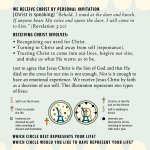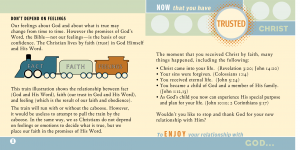I have been sharing these Connecting with God booklets for years with people of all ages. Here is a helpful instruction guide to give you ideas how to best share your faith using these booklets.
Using a booklet to share the gospel is helpful because it takes the pressure off of you. You don’t have to know what to say, you just have to be able to read. As you use a booklet, you will become more and more familiar with what to say when sharing your faith.
How to Begin:
Let them know you would like to go through the booklet with them. Following are several statements that can be used effectively in introducing it:
- “This booklet talks about how to connect with God in a personal way. Would you give me your opinion of it?”
- “The Bible talks about three things you need to know and one thing you need to do in order to have a relationship with God. This booklet summarizes what the Bible says. Can I share it with you?”
- When you believe someone may be a Christian but are not really sure, you could say, “I have been a Christian for years but I have just recently found a way to express my faith that really makes sense. Can I share it with you?”
Some tips for using “Connecting With God”:
Hold it so the person can see and read it along with you, or give each person you’re talking to a copy to follow along. Be sure to read it in a friendly tone and make it more personal by using his or her name as you go through the booklet. Being familiar with the booklet will contribute to your confidence and ability to make eye contact. Be careful, though, not to become mechanical. Remember, this person may be hearing the plan of salvation for the first time.
Once you begin sharing the booklet with a person, go slowly but steadily. As you are reading, ask, “Does this make sense?” As much as possible, follow the booklet word-for-word. If questions come up, say something like, “That’s a good question. Let’s see if it is answered later on. If not, we’ll come back to it.” Be sure, then, to return to the question or any issues you feel need further clarification after you are finished sharing the booklet. Do not get into arguments or try to force the person into a decision. Stay focused on Jesus and the power of His Word.
Certain words that Christians use often have a very different meaning or even no meaning at all to those who are unfamiliar with them. Taking time to explain what these words or ideas mean and asking a few simple questions will often help you to be certain that the person with whom you are sharing is understanding the message.
Questions and Illustrations
While you can simply read the booklet word for word, it can be helpful to insert questions or illustrations that help demonstrate its message. Here are some to consider using:

Page 1 & 2
After reading John 3:16, ask, “Have you ever heard this verse before?” Many have, and being able to say yes gives them a chance to feel they are relating to you. If they have not, it tells you a little of their church background or lack thereof. You can also ask, “What do you think the Bible means when it says ‘eternal life’?”
The question “What prevents us from knowing God personally?” can be asked directly, or you can read it and say, “The second point answers that question.” If asking the question directly, be sure you do not respond to her answer in a way that indicates she is “wrong.”
Page 3

People do not like to think of themselves as “sinful.” This is often due to the fact that we determine our “goodness” by comparing ourselves with other people rather than under- standing what sin is. If someone does not see that she is a sinner, she will never see her need for Christ. When you finish reading the paragraph on page four you may want to ex- plain sin further by explaining that the original Greek word for sin was used in reference to target practice. The distance from the bull’s-eye (perfection) to the actual hit was called “sin.” Therefore, sin is anything short of perfection.
After reading Romans 6:23 you may want to explain that the word “wages” refers to what we earn or deserve.
Page 4

After you read the paragraph explaining the arrows illustration, you could explain it fur- ther by pointing out that the arrows in the diagram are different lengths. If several people were trying to jump across the Grand Canyon, some would get farther than others, but all would fail. Some people may be “less sinful” than others, but each one misses perfection in her own efforts.
The word “religion” may be confusing. Explain that “religion” is man’s efforts to reach God. Ask, “What are things you see people doing to try to ‘reach God’?”
Page 5

Jesus is God’s only provision. There are not many ways to God; there is one way. You need to communicate that this is not simply your opinion. It is Jesus’ unique claim. You can explain this when you read John 14:6 on page seven. As you read it, underline the words “no one.”
Page 6

After reading the paragraph explaining the diagram on page six, ask, “What is different about the arrow in this diagram and the arrows in the diagram on page five?” She should notice or you can point out that the one on page seven points down (God’s efforts to reach out to man), and that it reaches all the way across the gap. You can use this to point out that while we cannot reach God by any of our own efforts, He provided the one way for us to know Him through Christ’s death and resurrection.
Jesus’ death was an acceptable, complete payment for the sin of mankind. He was God, lived perfectly, and offered Himself as a sacrifice.
Page 7

In Ephesians 2:8-9, “grace” and “faith” are words that Christians hear often but those with little spiritual background may not understand. You can explain that grace is “getting what you don’t deserve.” It would be like charging millions of dollars to a credit card then having someone pay it off for you. You should have to pay it, and you deserve to face the penalties for not being able to pay it. However, if someone else can afford to pay your debt and does so willingly, you experience grace.
Faith is trust. It is like sitting in a chair. If you’ve never sat in it before, you must place your faith in it to hold you.
Page 8

After reading through the point just before the circle diagrams, you may want to explain further what it means to “receive Christ.” You could explain that “receiving Christ” means accepting His offer of payment for her sin by His death on the cross. Receiving Christ is like getting engaged to be married. Simply agreeing intellectually that this person is a good mate, or admitting deep emotional feelings, does not make you engaged. It is not until you say “Yes” as an act of the will that you are truly engaged to be married.
When you ask “Which circle best represents your life?,” you are trying to determine if Christ is in his or her life or outside of his or her life.
- If his response is, “The circle on the right,” this could mean any of three things:
- He may have indeed received Christ at some point in his life.
- He may be saying this because he is confused in some way. For example, he may have grown up in church and think that alone means he has Christ in her life.
- He may be saying what he thinks you want to hear. In any case, when he responds with “the circle on the right,” say something positive, such as, “That’s great. How long have you had Christ in your life?” Or, you could say, “I made this decision when I was in college. How did you come to make your decision?” In gaining more information, you may be able to tell whether he is truly a believer.
- If her response is, “The circle on the left,” proceed to the next question. If her response is something such as, “I don’t know; somewhere in between,” ask, “Why do you say that?” Again, she may be confused as to how Christ comes into a life. If so, explain again the idea of receiving Christ by faith, as an act of the will. When you ask “Which circle would you like to have represent your life?”:
- If his response is, “The circle on the right,” proceed with the booklet.
- If her response is, “The circle on the left,” say something such as, “Someday you may change your mind and be interested in investigating further the claims of Christ. You might want to know what receiving Christ involves. Do you mind if I show you one last page?” (referring to page 10).
- If his response is, “I don’t know,” say something such as, “Could you tell me what you’re unsure about?” Try to deter- mine if he is confused or is unwilling to make the commitment. If the former, try to clear up any issues causing confusion. If the latter, encourage him to give it more thought. Ask, “What would you say is the one thing that is keeping you from inviting Christ into your life right now?” Make sure he understands how he could receive Christ by going on to the next page.
Page 9

Emphasize that the prayer in the booklet simply expresses an attitude, and that the words in themselves are no magic formula. If you sense a shyness in the person, explain that she can pray this prayer in the privacy of her own home. Encourage her to tell you someone she trusts so that if she does pray the prayer, further information can be provided to help her learn more about her decision.
Page 10

If she does pray the prayer with you, as you read this paragraph have her go back and read Revelation 3:20 again (page 8). Ask if she understands that Christ is now in her life.
After reading I John 5:12-13, emphasize “that you may know.” John could have used other words instead of know such as think, wish, hope or feel. His intention was to communicate that we should be confident in knowing we have eternal life. It is not presumptuous to say that you can know that you have eternal life and that nothing can ever take that away. In Hebrews 13:5, God is placing the strongest possible emphasis on the fact that He will never leave you.
Page 11 & 12

This page helps people who say, “I asked Christ to come into my life, but I just don’t feel any different.” If, because of this, she says she has trusted Christ more than once, refer again to Revelation 3:20 and tell her, “If Christ said He will come in, we do not need to continue asking Him.”
Page 13

Talking with them about continued growth in Christ provides a great opportunity for you to initiate continuing follow up with them. Say something like “I have some Bible study material that goes more in depth about each of these topics. Would you want to start meeting to go through it?” If they say yes, use basic follow up materials like “The Four Follow Ups” or “The Essentials.”
Page 15
This is a great opportunity to invite them to join you at your church. If they are friends with students you know who attend a good church, encourage and arrange for them to attend there.
from http://www.cruhighschool.com/resource/tool-to-share-the-gospel/
